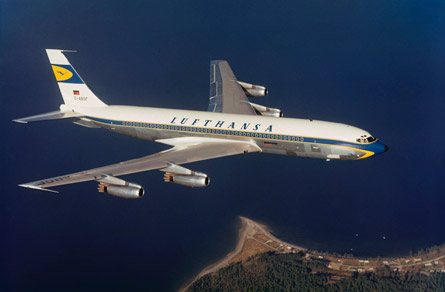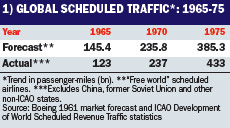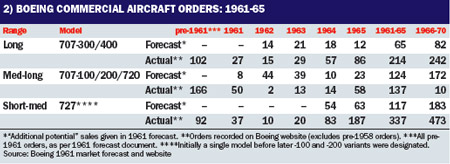Unveiling Boeing's 2009 perspective on future commercial aircraft demand, marketing vice-president Randy Tinseth produces possibly the only extant copy of the first such document, published almost 50 years ago.
The confidential 1961 publication had suggested the levels of production in each of the coming five years (complemented by an overall 10-year projection) that the US manufacturer's equipment and systems suppliers should be ready to support.
The sepia-pink pages have preserved Boeing's perception of "free world" airline traffic (passenger-miles) volumes that might be generated in 1965, 1970 and 1975, the products against which its sales staff were competing, and just a hint of possible future developments. Boeing hoped to attain a "good" market share in the mid-1960s, when requirements were expected to be "far in excess of existing and on-order aircraft".
 |
|---|
© LufthansaA Boeing 707 in Lufthansa livery. By April 1961, Boeing had sold 360 commercial jetliners, a claimed 42% market share and the order backlog covered 286 four-engined 707s... |
Today's equivalent forecast, Boeing's annual Current Market Outlook, projects a longer, 20-year view of traffic trends and consequent global requirements for aircraft (with 100-plus seats). In contrast, the original forecast was restricted to the short-term market for the company's five 707 variants (defined by capacity, range, and engine supplier) and the then-new 727.
ORDER NUMBERS
Tinseth describes the present-day outlook as "the longest-running complete worldwide jet forecast", but the original forecast looked no further than the number of orders its own aircraft might win, rather than total market requirements. Nevertheless, the document noted the Boeing jet transport programme's "solid success".
By April 1961, Boeing had sold 360 commercial jetliners, a claimed 42% market share, and the order backlog covered 286 four-engined 707s and 92 trijet 727s, including 40 727s each for Eastern Air Lines and United Air Lines in December 1960.
Since these latter 80 aircraft represented 32% of Boeing's accumulated orders - and followed the mid-1960 sale of 29 707s within 35 days - it is tempting to wonder if such business stimulated Boeing's formal consideration of market prospects.
The 1961 forecast provided a "basic outline" of Boeing activity. The company hoped suppliers would find the material "useful in developing their own plans for the promising years ahead". Boeing foresaw remaining 1961 demand for just eight 707s, with no further 727 orders predicted before 1964. Nevertheless, the jetliner programme was "moving forward on a sound basis of market research and analysis toward new technological growth, new products, new accomplishments".
Early research began with the character, growth, location, size and timing of world air travel to determine the market demand. "Traffic forecasting is essential to airframe programming," noted Boeing. The manufacturer considered requirements for military transports, as well as "great possibilities" in the "fast-growing" air cargo market, which "must be kept under constant study".
Boeing recognised that "world trade balances, population growth, income, financing [and] credit" affected travel. In an indication of the company's world view, the forecast concluded that such economic factors "must be co-related to Boeing plans", rather than the other way round - although it conceded that the business plan "must be adjusted to the market".
Research was fed by academic institutions, customer contact, economic and financial studies, market analysis, operations engineering, private consultants and technical and trade associations. Results developed and improved product planning and focused Boeing's "design, development, and delivery objectives".
MARKET NEEDS
Products would "fit recognised market needs", a familiar Boeing refrain that does not always match reality: it has never convincingly explained what drove the short-lived 2001 Sonic Cruiser project.
The 1961 forecast drew (see table 1 below) on a 1958 Boeing projection of passenger traffic up to 1975 for predicted early 1960s' order and delivery trends. In hindsight, it can be seen the short-term forecast is over-optimistic and the longer-term traffic prediction pessimistic: by 1975, traffic had risen far more than expected.

Boeing noted that increasing traffic required more aircraft to provide adequate capacity, but such growth also could have been accommodated by larger aircraft, a concept that has challenged Boeing in recent years. It discovered "the middle of the market", at which it is aiming the new 787, and said average aircraft size was not increasing: the real demand was for smaller machines that would fly directly between secondary city pairs.
The forecast also saw opportunities to expand into cargo. With air freight operations seen as expanding "sharply" by 1965, Boeing said it would become "increasingly active in this field". Mention is made of a "Model 735 cargo jet" - thought to have been a two-variant, "swing-tail", 707-based freighter, of which the Model 738 was a possible military version. The Model 735 would compete against freight versions of the Douglas DC-8 and, possibly, the Convair CV-990 - both predicted to enter service in 1962.
Little detail supports the 1961-65 commercial aircraft forecast (see table 2 below) beyond noting that by 1970, the 727 would represent "a very important portion" of deliveries. Boeing grossly under-estimated prospective 707 orders in the early 1960s (189 predicted against 351 achieved) and 727 orders throughout the decade (300, compared with 810).

Strong passenger market growth in 1965- 1970 was expected to stimulate robust non-US competition that would drive a need for "technical quality, early deliveries, and competitive prices" in Boeing products. The forecast predicted 887 overall commercial "sales" in 1961-70, compared with the quoted orders for 743 707s and 727s. The balance covered possible orders for 90 Model 735 freighters and for 19 Model 733 supersonic transports (SST).
In predicting deliveries, as opposed to orders, (see table 3 below) Boeing forecasts were reasonably accurate for the first five years, possibly as they covered actual production slots.
Analysis of the relevant graph (compared with actual deliveries recorded on the Boeing website) suggests the 1962 total was close and that, combined, 1963 and 1964 were accurate before orders wildly exceeded expectations in the following six years. (The Boeing website "orders and deliveries" pages embed statistics for Douglas designs among "true" Boeing figures.)

An expected decline in 1968-1970 deliveries was explained by the suggestion "that many airplanes will be large and sophisticated. Their systems will be highly developed. It requires no stretch of the imagination to visualise, for instance, the equipment costs involved in a supersonic airplane."
In other considerations, Boeing foresaw further military 707 variants beyond the KC-135 tanker that had stimulated the basic 707 commercial design, including weather reconnaissance and early warning models, and estimated the US Air Force would need a further 313 aircraft beyond the 547 on order.
Boeing was aware that the 1960s offered airlines a selection of equipment, saying: "[Our] share of the market is estimated in the light of competitive developments [that] must be studied carefully."
Long-range competition came from the DC-8, with the UK's planned Vickers VC10 seen as a contender from 1964. Sharing a similar design configuration to the 707 and DC-8, the CV-880 and CV-990 rivalled the medium- to long-range 707-120B and the lighter and shorter 707-020 (marketed as the Model 720), with the already ageing de Havilland Comet.
The French Sud Caravelle was established in the short- to medium-range market, but "the 727 far exceeds the Caravelle in sales potential", opined the forecast. Boeing also foresaw competition from the UK's de Havilland Trident and the British Aircraft Corporation 107, the latter emerging as the One-Eleven.
By 1970, when requirements would have "assumed even greater relative importance", Boeing expected to offer an improved and expanded product line but provided few clues beyond passing references to the Model 735 and the SST.
Teasingly, the initial forecast cited the "possibility of some US short-range jet being developed", although it is unclear whether this referred to the 737 (still more than three years away from launch in early 1961) or the Douglas DC-9.
Tinseth emphasises the validity of current Boeing forecasts: "Each year, in a sense, we tear up the old forecast and start fresh with new analysis. It's how we make sure [it] takes current market conditions into account."
Source: Flight International























